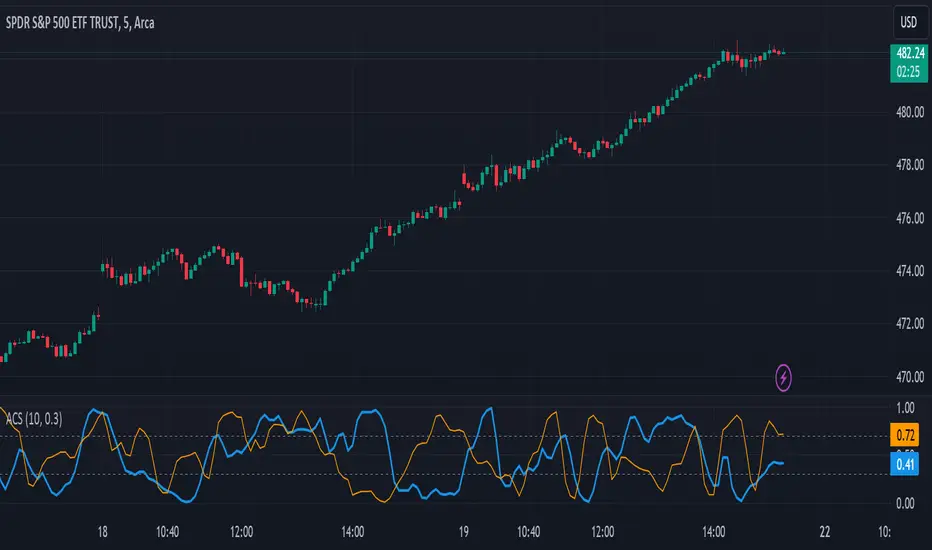OPEN-SOURCE SCRIPT
Activity & Chop Score
Updated

Release Notes:
The Activity and Chop Score was designed to help traders quickly determine if a market is active and/or choppy (not moving with any urgency). Slow and chopping markets should be approached with caution or avoided.
How does it work? The Activity Score incorporates momentum and the linear regression. Momentum (change in price over time) is compared over a long and short time period. Active markets are when those are moving together. This is combined with a linear regression of the price to determine the Correlation Coefficient (r^2) to measure of trend strength. The score is a is the average of the two momentum values, normalized by the standard deviation, and scaled by the trend (r^2 value). Chop is defined as divergence between long and short momentum periods. The divergences (chop) are quantified with a Jaccard Similarity Score, normalized by the standard deviation, and averaged to create a score.
How can you use it? This indicator is best used on lower timeframes. Activity Scores Values below 1 are considered low and values over 2 are high. Avoid markets where the Activity Score is below 1. There is an alert threshold in the options. Pivots are worth paying attention too as well as they indicate the start and stop of a recent move. You can compare markets or assets with the Chop Score. You make chose to avoid those with higher Chop Score. The position of the two lines relative to each other are useful. Ideally, the Activity Score is higher than the Chop Score. As with any indicators, it should be used in combination with others that best suits your trading style.
The Activity and Chop Score was designed to help traders quickly determine if a market is active and/or choppy (not moving with any urgency). Slow and chopping markets should be approached with caution or avoided.
How does it work? The Activity Score incorporates momentum and the linear regression. Momentum (change in price over time) is compared over a long and short time period. Active markets are when those are moving together. This is combined with a linear regression of the price to determine the Correlation Coefficient (r^2) to measure of trend strength. The score is a is the average of the two momentum values, normalized by the standard deviation, and scaled by the trend (r^2 value). Chop is defined as divergence between long and short momentum periods. The divergences (chop) are quantified with a Jaccard Similarity Score, normalized by the standard deviation, and averaged to create a score.
How can you use it? This indicator is best used on lower timeframes. Activity Scores Values below 1 are considered low and values over 2 are high. Avoid markets where the Activity Score is below 1. There is an alert threshold in the options. Pivots are worth paying attention too as well as they indicate the start and stop of a recent move. You can compare markets or assets with the Chop Score. You make chose to avoid those with higher Chop Score. The position of the two lines relative to each other are useful. Ideally, the Activity Score is higher than the Chop Score. As with any indicators, it should be used in combination with others that best suits your trading style.
Release Notes
The Activity and Chop Score was designed to help traders quickly determine if a market is active and/or choppy (not moving with any urgency). Slow and chopping markets should be approached with caution or avoided.How does it work? The Activity Score incorporates momentum and the linear regression. Momentum (change in price over time) is compared over a long and short time period. Active markets are when those are moving together. This is combined with a linear regression of the price to determine the Correlation Coefficient (r^2) to measure of trend strength. The score is a is the average of the two momentum values, normalized by the standard deviation, and scaled by the trend (r^2 value). Chop is defined as divergence between long and short momentum periods. The divergences (chop) are quantified with a Jaccard Similarity Score, normalized by the standard deviation, and averaged to create a score.
How can you use it? This indicator is best used on lower timeframes. Activity Scores Values below 1 are considered low and values over 2 are high. Avoid markets where the Activity Score is below 1. There is an alert threshold in the options. Pivots are worth paying attention too as well as they indicate the start and stop of a recent move. You can compare markets or assets with the Chop Score. You make chose to avoid those with higher Chop Score. The position of the two lines relative to each other are useful. Ideally, the Activity Score is higher than the Chop Score. As with any indicators, it should be used in combination with others that best suits your trading style.
Updated to displace scores in percent to enhance comparisons on difference timeframes.
Release Notes
Updated to show scores in percent to make it improve use on different timeframes.Open-source script
In true TradingView spirit, the author of this script has published it open-source, so traders can understand and verify it. Cheers to the author! You may use it for free, but reuse of this code in publication is governed by House rules. You can favorite it to use it on a chart.
Disclaimer
The information and publications are not meant to be, and do not constitute, financial, investment, trading, or other types of advice or recommendations supplied or endorsed by TradingView. Read more in the Terms of Use.